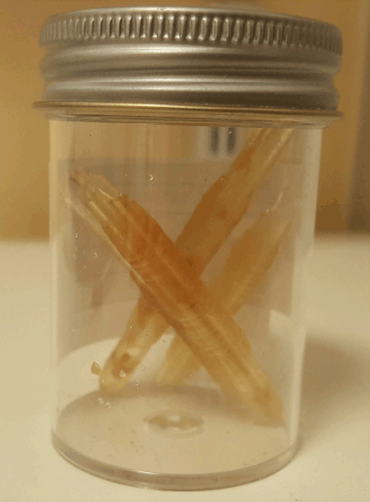| Table of Contents |  |
|
Clinical Images
| ||||||
| Intravesical foreign bodies mimicking bladder calculi | ||||||
| Andrew Colin Brodie1, Sadegh KhoshZaban2, Aharani Kirupanandan3, Aasem Chaudry4 | ||||||
|
1Core Surgical Trainee Year 2, Urology, Bedford Hospital, UK.
2Foundation year 2, Urology, Bedford Hospital, UK. 3Foundation Year 1, Urology, Bedford Hospital, UK. 4Consultant Surgeon, Urology, Bedford Hospital, UK. | ||||||
| ||||||
|
[HTML Abstract]
[PDF Full Text]
[Print This Article]
[Similar article in Pumed] [Similar article in Google Scholar] |
| How to cite this article: |
| Brodie AC, Zaban SK, Kirupanandan A, Chaudri A. Intravesical foreign bodies mimicking bladder calculi. J Case Rep Images Urol 2017;2:1–3. |
|
Case Report
| ||||||
|
A 35-year-old male presented with a seven-day history of intermittent suprapubic pain associated with nausea and vomiting. The patient had a complex urological history including an augmentation cystoplasty at the age of 10 years for a congenital neurogenic bladder, two traumatic bladder ruptures requiring open repair at the age of 13 and 20 years and the formation of a Mitrofanoff appendicovesicostomy [1] for intermittent self catheterization. On presentation the patient’s Mitrofanoff was catheterized with a 14-French long-term Foley catheter as the patient was finding self-catheterization painful. A plain abdominal radiograph (Figure 1) revealed several calcifications in the area of the bladder consistent with bladder calculi. A non-contrast computed tomography scan of the urinary tract confirmed the presence of tubular calcifications in the bladder presumed to be bladder calculi. The patient underwent emergency cystoscopy revealing the calcified cut ends of four urethral catheter tips (Figure 2). Cystolithopaxy was performed to crush these calcified foreign bodies facilitating cystoscopic removal. On further questioning the patient later admitted to cutting the catheter tips himself and was discharged 10 days later after psychological assessment. | ||||||
| ||||||
| ||||||
|
Discussion
| ||||||
|
Foreign bodies within the bladder are a rare phenomenon and mechanism of introduction includes self-insertion, penetrating injury, iatrogenic and migrations from another organ system [2]. The motivation behind self-insertion often relates to sexual gratification or psychological illness and thus often the history may not forthcoming due to patient embarrassment. Consequently, intravesical foreign bodies can pose an interesting diagnostic dilemma in the emergency setting. Radiological imaging, particularly in the form of computed tomography, is vital in diagnosis, however, it may fail to distinguish calcified foreign bodies from true bladder calculi as in the case presented. Wherever possible endoscopic removal is preferable but larger objects may necessitate open retrieval [3]. It is important to note there have been reported mortalities 33 associated with intravesical foreign bodies and thus prompt diagnosis and removal may be lifesaving when dealing with overwhelming sepsis or vesical perforation [4]. | ||||||
|
Conclusion
| ||||||
|
Self-inserted intravesical foreign bodies are a rare occurrence. The history may be unreliable due to patient factors and thus the clinician must have a high index of suspicion in the face of unexplained and recurrent urinary symptoms. Early radiological imaging is a key step in diagnosis and will often involve computed tomography. Management strategies vary, however, they are broadly categorized into open and endoscopic. It is vitally important that the patient’s mental health is both assessed and managed to avoid future recurrences. | ||||||
|
Keywords:
Bladder calculi, Cystolithopaxy, Foreign body, Mitrofanoff appendicovesicostomy
| ||||||
|
References
| ||||||
| ||||||
|
[HTML Abstract]
[PDF Full Text]
|
|
Author Contributions
Andrew Brodie – Substantial contributions to conception and design, Acquisition of data, Drafting the article, Revising it critically for important intellectual content, Final approval of the version to be published adegh Khoshzaban – Substantial contributions to conception and design, Acquisition of data, Drafting the article, Revising it critically for important intellectual content, Final approval of the version to be published Aharani Kirupanandan – Substantial contributions to conception and design, Acquisition of data, Drafting the article, Revising it critically for important intellectual content, Final approval of the version to be published Aasem Chaudry – Substantial contributions to conception and design, Acquisition of data, Drafting the article, Revising it critically for important intellectual content, Final approval of the version to be published |
|
Guarantor of submission
The corresponding author is the guarantor of submission. |
|
Source of support
None |
|
Conflict of interest
Authors declare no conflict of interest. |
|
Copyright
© 2017 Andrew Brodie et al. This article is distributed under the terms of Creative Commons Attribution License which permits unrestricted use, distribution and reproduction in any medium provided the original author(s) and original publisher are properly credited. Please see the copyright policy on the journal website for more information. |
|
|





